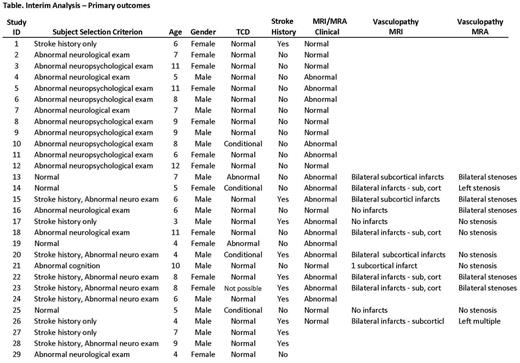Abstract
Sickle Cell Anemia (SCA) is highly prevalent in sub-Saharan Africa (SSA). In Uganda, approximately 20,000 children are born with SCA annually (Ndeezi G, 2016). Sickle brain vasculopathy causes both overt strokes and clinically "silent infarcts," affecting neurological and cognitive function (DeBaun MR, 2012). Incidence of strokes has markedly decreased through standardized preventative measures. Study objectives are to determine the age-related spectrum and burden of brain injury associated with SCA in Ugandan children, determine predisposing risk factors and build capacity to support interventions for stroke prevention. Here we present preliminary results.
Methods: BRAIN SAFE is a cross-sectional study of a random sample of 250 children with SCA, ages 1-12 years, who receive care at the Mulago Hospital SCD clinic in Kampala.Potential participants were randomly selected from the clinic roster. Study exclusion criteria: hemoglobinopathy other than HbSS or HbS B0 thalassemia, age >12, acute illness, Hb <6.0gm/dl, recent transfusion, participation in another clinical study.
Stroke history and examination: were performed using the pediatric NIH Stroke Scale. Psychometric testing: Age-appropriate KABC-II, TOVA, BRIEF and Mullen testing were performed by skilled testers using validated versions in English or the predominant local language.
Transcranial doppler ultrasounds (TCDs) were performed (with good inter-operator reliability) by two study staff, both health professionals. They had been trained by a U.S.-based "STOP" trial TCD research nurse and a co-investigator who had TCD training in the U.S. The latter also performed standardized readings (Adams RJ, 1998). Quality assurance for TCD readings was provided by an independent stroke neurologist.
Brain Magnetic imaging (MRI/MRA): Using a single 1.5T scanner, a subset of subjects enriched for a history of stroke, abnormal neurological exam and/or cognitive testing. Two radiologists performed clinical reads. An independent neuroradiologist assessed sickle vasculopathy, per "SWiTCH" protocol (Helton KJ, 2014), blinded to clinical and radiological data.
Primary and secondary stroke prevention : Subjects with persistently non-normal TCDs on repeat testing or vasculopathy on MRI/MRAswill be offered hydroxyurea .
Results: Of the 248 participants screened in the 1st funding year, 233 were enrolled (mean age 5.62 years (range 1-12). Study exclusions due to age >12, acute illness, severe anemia, recent transfusion or participation in another study.
History and neurological exam : Overall, 7 of 233 had history consistent with a stroke, and an abnormal neurological exam, 5 had a history consistent with stroke but a normal neurological exam, 6 had abnormal neurological findings but no history of stroke (total abnormal 18/233, 7.7%).
Psychometrics : To date, cognitive test data results have been performed on 80 children; 30 (37.5%) were impaired with varying severity. (Full reports to follow.)
TCDs : A total of 224 non-imaging TCDs have been performed. Using standard criteria, 190 were normal, 4 abnormal (1.8%), and 30 conditional (13.4%). Repeat TCDs have been performed on 13 of those with non-normal reads and so far, 2 were abnormal, 6 conditional, 4 normal,1 had difficult windows.
MRI/MRAs: A subset of 29 subjects were selected with more clinical and/or historical stroke pathology (N= 25, 86%) and have undergone MR imaging to date (see Table). Mean age was 7.1 years (range 3-12); male: 55%. Of 26 with clinical radiological reads, 16 / 26 (61.5%) were abnormal. To date, scans from 12 subjects have had SCD vascular reads: 2 had no vasculopathy; 10 were abnormal: 6 with infarcts and arterial stenoses, 3 with infarcts only, 1 with bilateral stenoses only.
Conclusions: BRAIN SAFE, a Kampala-based cross-sectional study, has already enrolled and completed a large proportion of study procedures. Considerable brain pathology has been identified in all aspects tested, with high prevalence of abnormal history or physical findings, abnormal psychometrics, abnormal cerebral blood flow and/or brain MR imaging. Completion of enrollment and testing for the target sample will provide baseline data for longitudinal assessment and intervention. Building research capacity for faculty and trainees is ongoing.
Acknowledgments: 1R21HD089791 (PIs: Idro, Green) and Latanya Bowman, RN, Augusta University Sickle Cell Center.
No relevant conflicts of interest to declare.
Author notes
Asterisk with author names denotes non-ASH members.


This feature is available to Subscribers Only
Sign In or Create an Account Close Modal